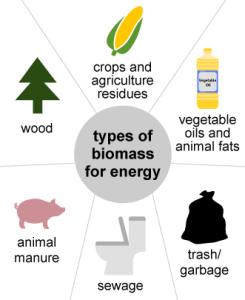
What’s That Wednesday – Biomass
Renewable energy has many sources, including Biomass, hydropower, wind, and solar power. Today’s ‘What’s That Wednesday’ will cover what Biomass is and how the various materials that compose it can also be used as renewable energy sources. Let’s get into its nature and utilization in energy production.
What is it?
Biomass, a form of renewable energy, consists of organic materials derived from animals and plants, including agricultural crops, crop residues, municipal solid waste, wood, and animal waste. It serves as a renewable source of energy through processes such as gasification, combustion, and fermentation. Its renewability stems from the ability to regrow plants, making it a sustainable alternative to fossil fuels for producing heat, electricity, and biofuels. The key characteristic is that it is derived from living or recently living organisms, making it a renewable resource, unlike finite fossil fuels.
Energy is harnessed through the carbon cycle. Plants absorb carbon dioxide (CO2) from the atmosphere during photosynthesis, a process that also produces oxygen. When burned or biodegraded, CO2 is released back into the atmosphere, where it can be reabsorbed by plants. This cycle can theoretically balance out carbon emissions, provided new plants continue to grow in place of those used for energy.
How is it used?
Biomass serves many functions in renewable energy, particularly within the industrial and fuel sectors. In industrial applications, it provides heat or steam for processes such as manufacturing and food processing. In the fuel industry, biomass transforms into a sustainable energy source that avoids carbon emissions. It can be converted into liquid biofuels like ethanol and biodiesel, serving as alternatives to gasoline and diesel in vehicles.
Another important use is in biogas production. Organic waste materials are fermented in anaerobic digesters to produce biogas, which can be utilized for heat, electricity generation, or as vehicle fuel.
Additionally, biomass contributes to carbon sequestration, where carbon dioxide is stored in carbon pools. By managing biomass sustainably, plants absorb carbon dioxide during growth, helping to mitigate emissions from fossil fuels. This process is crucial in reducing atmospheric carbon dioxide levels.
How does it factor into energy?
Biomass is used as an energy source, otherwise known as feedstocks, and some, such as plant material, derive their energy from the sun. Through photosynthesis, plants gather energy from the sun, converting carbon dioxide and water into nutrients. The energy from these organisms is transformed into usable energy. In the fuel and oil industry, it is valuable when processed into biofuel. In addition to the benefits of transforming biomass into biofuels, it offers a variety of benefits across different sectors.
As a sustainable and organic substance, energy significantly reduces greenhouse gas emissions. Burning biomass releases essentially the same amount of carbon dioxide as burning fossil fuels, but it burns carbon dioxide that is balanced by the carbon dioxide captured during its growth, rather than releasing fossilized carbon, making it one of the most promising renewable energy sources.
Biomass is making headway within the fuel and oil industry, helping create sustainable solutions like ethanol and biodiesel. Its use helps reduce carbon emissions as industries increasingly adopt biomass. While the U.S. economy still heavily relies on fossil fuels across various industries, reducing carbon emissions overall remains a gradual process. One of the United States main focus areas to decrease carbon emissions is biofuels like ethanol and biodiesel. Biomass continues to be a promising renewable energy source for transportation and is paving the way for sustainable alternatives. Up until the mid 1800’s, it was the primary driver of the nation’s yearly energy consumption. Nearly 5% of the main energy source used in the US during 2022 was generated by biomass.
The nation’s transportation sector has also been attributed to having the second-highest percentage share and amount of biomass consumption in 2022. Additionally, in 2022, U.S. total exports exceeded all imports. Researchers are continuously working to improve biomass conversion methods and develop new ways to convert biomass to renewable energy.
As agricultural technology progresses, scientists are developing the resources necessary to utilize residues such as corn stover and wheat straw as biomass sources. With the growth of more sustainable feedstocks, the entire cycle will become sustainable. Biomass paves the way for renewable energy that is both sustainable and useful.


This article is part of Daily Market News & Insights
Tagged: biofuels, gasoline, Renewable Fuels
MARKET CONDITION REPORT - DISCLAIMER
The information contained herein is derived from sources believed to be reliable; however, this information is not guaranteed as to its accuracy or completeness. Furthermore, no responsibility is assumed for use of this material and no express or implied warranties or guarantees are made. This material and any view or comment expressed herein are provided for informational purposes only and should not be construed in any way as an inducement or recommendation to buy or sell products, commodity futures or options contracts.





